1. Electric Eel: The Underwater Taser That Delivers 860 Volts

Pexels/ Mojca J
The electric Eel can generate a whopping 860 volts of electricity, making it the strongest bioelectric animal on the planet. According to the Smithsonian’s National Zoo, electric eels can produce shocks of up to 800 volts, which they use for hunting and self-defense. That’s more than six times the voltage of a standard wall socket! But it doesn’t just zap everything in sight—this fish is a master tactician. It has three different electric organs that let it sense, track, and kill its prey. When hunting, it first releases weak electrical pulses to navigate the dark waters, kind of like an underwater metal detector. If it picks up movement, it switches to medium-strength pulses to scan its target. And then comes the knockout punch—a massive electric surge that completely stuns its prey. This shock is so powerful that scientists have recorded eels leaping out of the water to attack threats, delivering electric jolts directly into the air! If you ever find yourself wading through the Amazon, let’s just say you might want to avoid stepping on one of these.
2. Black Ghost Knifefish: The Ninja of the Electric World
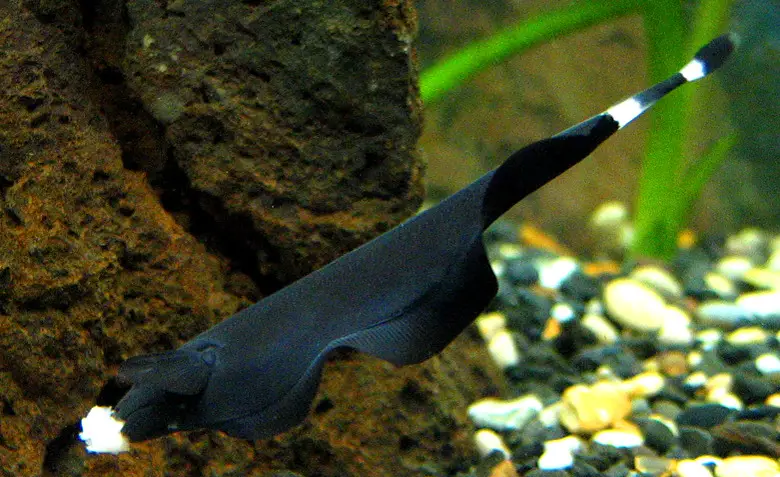
Flickr/ Andripogo
The black ghost knifefish is an aquatic marvel, shrouded in mystery and intrigue. Known as the “ninja of the electric world,” this fish lives up to its name through its stealthy behavior and electrifying abilities. With its long, slender body and smooth, knife-like tail, it glides through the water with remarkable agility and silence, evading detection as it hunts its prey in the dimly lit rivers of South America.
What makes the black ghost knifefish truly exceptional, though, is its ability to generate weak electric fields. These electric discharges are used for navigation, communication, and hunting in the murky waters where visibility is limited. The fish has specialized electroreceptors along its body that allow it to detect the faintest movements of nearby prey or objects, essentially allowing it to “see” through electricity. Like a true ninja, it remains hidden in the shadows, relying on its electric sense to track and capture prey with pinpoint accuracy. Stealth, precision, and the power of electricity make the black ghost knifefish a true assassin of the aquatic world.
3. Electric Catfish: Africa’s Angry Voltage Tank
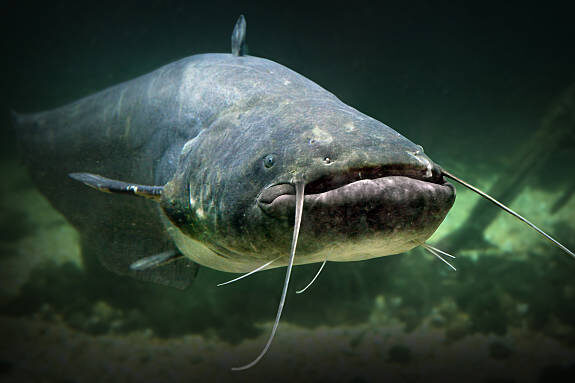
Imagine reaching into the water to grab a fish, only to be met with a sudden electric shock that makes your hand go numb. Congratulations! You’ve just met the electric catfish—one of Africa’s most infamous shockers. Found in the slow-moving rivers of the Nile and beyond, this bottom-dwelling predator is equipped with specialized electric organs that allow it to release 350 volts of electricity. That’s not quite as strong as an electric eel, but it’s still enough to stun prey or give a painful zap to anything that gets too close.
What makes the electric catfish particularly fascinating is how it hunts. Unlike the eel, which fires off short, high-powered bursts, the electric catfish holds its charge for extended periods. It can release a continuous electric current, making it almost like a living electric fence. Any small fish that wanders too close gets overloaded with electricity, going into shock before it even knows what hit it. Even large predators tend to leave this grumpy catfish alone—after all, no one wants to mess with a fish that fights back with lightning.
4. Torpedo Ray: The Ocean’s Hidden Stun Gun
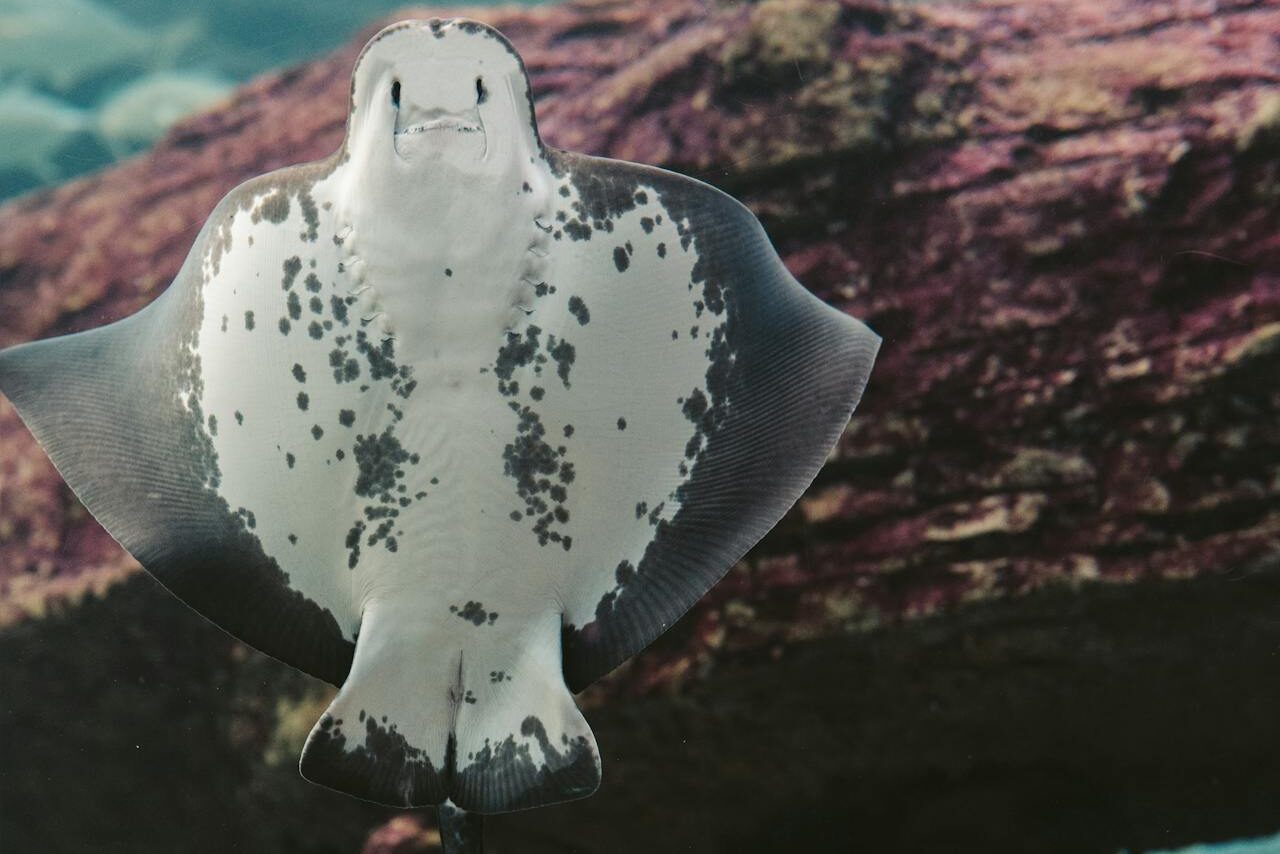
If you’ve ever wondered what a stingray with superpowers would look like, meet the torpedo ray. This flat, disc-shaped hunter lurks in the sandy seabed, waiting for prey to swim too close. Then, in a blink, it unleashes a devastating 220-volt electric shock, stunning its victim instantly. Unlike electric eels, which swim around zapping things, torpedo rays prefer the ambush approach. According to Britannica, electric rays can produce shocks strong enough to incapacitate a human adult.
Their hunting strategy is brutally effective. They bury themselves under the sand, lying in wait like a hidden landmine. When an unsuspecting fish passes overhead—BAM! The torpedo ray launches upward, wraps itself around its prey, and delivers a series of rapid-fire shocks. Within seconds, the fish is completely paralyzed, making it easy pickings for this underwater assassin. Some larger torpedo rays have even been known to zap divers, so if you’re ever swimming near the ocean floor, you might want to watch where you step.
5. Stargazer Fish: The Electrified Ambush Monster

Flickr/ Lusox
The stargazer fish is the ocean’s sneakiest predator, blending into its environment with deadly precision. Named for its upward-facing eyes that give it the appearance of constantly gazing at the stars, this fish hides just beneath the sand or mud, waiting for the perfect moment to strike. But what truly sets the stargazer apart isn’t just its camouflage or unique appearance—it’s its electrifying abilities.
This ambush predator has specialized electrical organs located on its head, capable of delivering powerful shocks. It uses this electric charge to stun or paralyze its prey, such as smaller fish or invertebrates, making them easy to capture. But the stargazer doesn’t just use its electric capabilities for hunting. It can also use these discharges to defend itself against threats. While its shock isn’t as powerful as that of some other electrified creatures, it’s enough to deter potential predators and keep the stargazer safely concealed in its sandy lair. With its mix of stealth, shock, and ambush tactics, the stargazer fish truly lives up to its title as the electrified monster of the deep.
6. Elephantnose Fish: The Brainy Electrosensor

While most electric hunters use their abilities to shock prey, the elephantnose fish takes a more sophisticated approach. According to AskNature, the elephantnose fish uses its electric organ to emit tiny pulses that bounce off nearby objects. This allows it to sense movement, locate prey, and navigate through the dark, murky waters where it resides. By actively generating and sensing an electric field, the fish can map out its environment in a process known as electrolocation.
Its electric organ sends out tiny pulses that bounce off objects, allowing it to sense movement, locate prey, and navigate in complete darkness. This makes it an expert at finding tiny insects and crustaceans hiding in the mud. What’s even more impressive? The elephantnose fish has one of the largest brain-to-body ratios of any fish, meaning it’s not just relying on electricity—it’s actually interpreting the signals in an incredibly complex way. If there were an IQ test for fish, this one would probably ace it.
7. Electric Rays: Stealthy Underwater Shockers
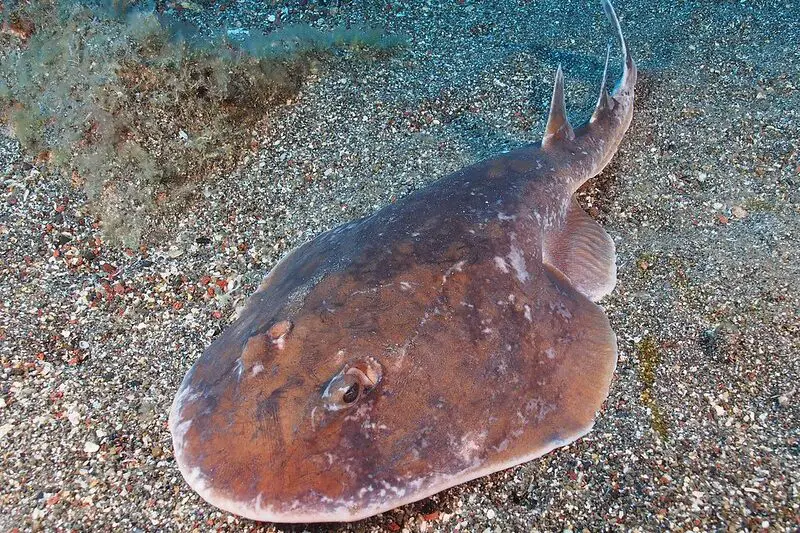
Closely related to torpedo rays, electric rays are another group of flat-bodied predators that use their shocking abilities to ambush prey. Found in oceans all over the world, these rays have specialized electric organs located on either side of their heads, which they use to release powerful electric shocks that can stun, paralyze, or even kill small fish and invertebrates.
Unlike electric eels, which actively chase prey, electric rays prefer the stealth approach. They bury themselves in the sandy ocean floor, waiting for an unsuspecting fish to swim by. The moment their prey gets too close, the ray lunges forward and wraps around its target, delivering a series of electric pulses that leave the fish completely immobilized. Once the victim is stunned, the ray swallows it whole—no struggle, no escape. Some species of electric rays, such as the Atlantic torpedo ray, can generate up to 220 volts—enough to knock out a medium-sized fish and even startle a human diver. Ancient civilizations, including the Greeks and Romans, were well aware of these creatures’ shocking abilities. In fact, they sometimes used electric rays as a primitive form of pain relief, believing the shocks could numb pain or cure headaches!
8. Knifefish: The Stealthy Ghosts of the Water

We’ve already talked about the black ghost knifefish, but did you know that several other knifefish species also use electricity to hunt? Knifefish are native to South America and Africa, and they use their electric fields in a more subtle way than the electric eel. Instead of shocking prey, they generate a weak electric signal that allows them to navigate dark, murky waters and detect tiny movements around them. According to Scientific American, this ability allows the fish to create a detailed map of its surroundings, enabling it to locate tiny insects, worms, and crustaceans buried in the sand.
The brown ghost knifefish and the glass knifefish are two species that rely on this ability to locate small invertebrates hiding in the riverbed. Their electric pulses bounce off objects in the water, allowing them to build a detailed “electric map” of their surroundings. This is extremely useful in low-visibility environments where eyesight is practically useless. What makes knifefish even more fascinating is that their electric signals are unique to each individual—almost like a fingerprint! They can recognize one another based on these signals, which helps them avoid territorial disputes with members of their own species. For a small, quiet fish, they’ve developed an incredibly advanced way to communicate, navigate, and hunt—all using electricity.
9. Peters’ Elephantnose Fish: The Ultimate Electrolocator

We already met the elephantnose fish, but there’s one species in particular that deserves its own spotlight: Peters’ elephantnose fish (Gnathonemus petersii). This African freshwater fish is a true master of electrolocation, using its elongated snout to probe the muddy riverbeds for food.Unlike electric eels, which use electricity as a weapon, Peters’ elephantnose fish generates weak electric fields to detect prey and obstacles in complete darkness. Its electric organ sends out pulses, and its highly sensitive skin picks up how those signals bounce back from nearby objects. According to a study published in Current Biology, this allows it to detect tiny insects, worms, and crustaceans buried in the sand.
But what’s truly mind-blowing is that this fish has an insanely large brain—one of the biggest brain-to-body ratios of any vertebrate! Scientists believe this is because processing all the complex electrical information requires serious brainpower. In other words, this fish is essentially using a form of biological sonar to hunt its prey, making it one of the most sophisticated electric hunters in the world.
10. Sharks: The Ocean’s Bioelectric Assassins

Wait, what? Sharks use electricity to hunt? Yes! Though they don’t generate electric shocks like electric eels or rays, sharks have one of the most advanced electro-sensory systems in the animal kingdom. Sharks are equipped with special jelly-filled pores called Ampullae of Lorenzini, which allow them to detect the tiny electric fields generated by living creatures. Every time a fish moves its muscles—even if it’s just breathing—it produces weak electrical signals. Sharks can pick up on these signals, which means they can sense prey even if it’s completely hidden under sand or in total darkness.
This ability gives sharks an incredible advantage. Even if a fish tries to stay perfectly still, hoping not to be noticed, a shark can still detect its heartbeat. Some species, like the hammerhead shark, have an even more advanced electro-sensory system due to the wide shape of their heads, allowing them to scan larger areas. So while sharks may not shock their prey like an electric eel, they are still one of the most efficient electric hunters in the ocean—and that’s pretty terrifying if you’re a small fish trying to hide.
11. Platypus: The Electrified Mammal

The platypus is already one of the most bizarre animals in the world, but what really sets it apart is its electrifying abilities. This curious mammal, native to Australia, is one of the few mammals that can generate an electric charge. While most mammals rely on sight, sound, or smell to interact with their environment, the platypus uses electroreception to sense the faint electrical signals emitted by its prey, primarily small invertebrates like shrimp or worms.
What makes this even more impressive is that it can do this while hunting underwater, with its eyes, ears, and nostrils closed, making it almost completely blind to its surroundings. The platypus has specialized electroreceptors in its bill, which help it pick up the electrical impulses from the movements of its prey. This “electric sense” is so sensitive that it allows the platypus to detect even the slightest muscle movements of creatures buried beneath the mud or sand. It’s like having an inbuilt radar system, but with the added bonus of being a mammal! The platypus isn’t just a strange creature—it’s an electrified marvel of nature.
12. Bony Fish Larvae: The Tiny Shockers
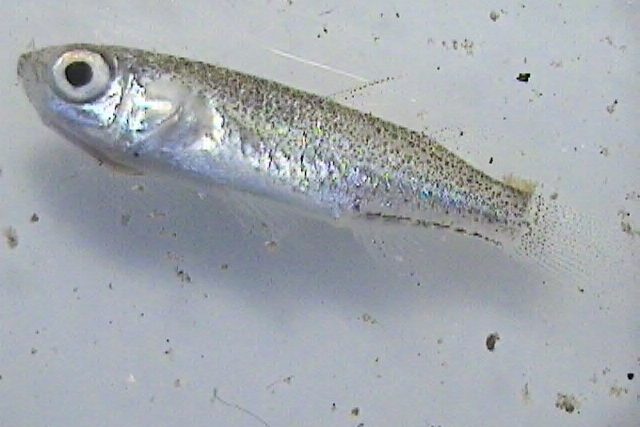
Bony fish larvae, despite their delicate appearance, pack a powerful punch. These tiny creatures, in their early stages of life, are known for their surprising ability to generate electrical discharges. It’s a feature that might seem more fitting for electric eels or stingrays, but bony fish larvae have their own unique twist on it. They use these electrical bursts primarily for hunting and communication, sending out little shocks to disorient their prey or navigate through their environment.
But their power doesn’t stop there. These larvae are highly adaptable, able to survive in various habitats by utilizing their electrical abilities to protect themselves from predators and other threats. What makes them truly fascinating is how their electric potential continues to develop as they grow, preparing them for a life full of strategic moves in the ocean’s complex ecosystem. With their mix of vulnerability and strength, bony fish larvae remind us that even the smallest creatures can have some shocking surprises up their fins.
13. Dolphins: The Secret Electrosensors

Believe it or not, some species of dolphins have been found to possess a primitive form of electroreception! While they don’t rely on it as much as sharks or electric fish, researchers have discovered that the Guiana dolphin can detect weak electric fields in the water, possibly helping it locate prey hidden in the sand. According to Science Adviser, while electroreception is well documented in fish and amphibians, this discovery suggests that such sensory abilities may be more common in mammals than previously thought. The Guiana dolphin’s ability to sense electrical stimuli allows it to hunt effectively in turbid waters where visibility is poor.
This suggests that electrosensing may be more common in mammals than previously thought. Could this mean other marine mammals have hidden electric abilities we haven’t discovered yet? Only time will tell!


